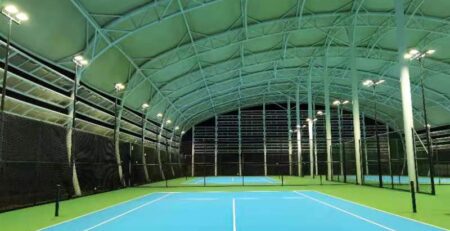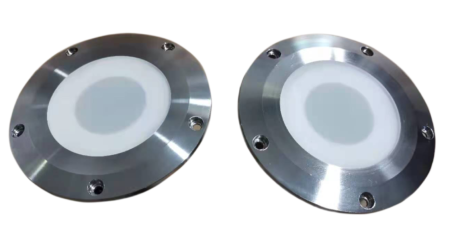How to choose an appropriate floodlight for your sports venue?
Tips for LED Floodlight Selection
LED floodlight is a confusing technology nowadays. Even the most professional designers and contractors might have difficulties in its selection. This article aims to explain some technical tips on components to ease the sports floodlight selection.
1. Drivers Selection
Firstly, driver is a crucial device that regulates power to an LED or a string of LEDs. Any high power floodlighting operation without proper drivers will result in severe system failure or fire disaster. Thus, having an appropriate driver is the first step to have a suitable LED floodlight.
Like all the other things, each component of the driver can direct its final quality. What we are mainly going to discuss is the safety references that hidden in a competitive market. Manufacturers prefer to obscure its feature by a respected technical name, constant current driver.
1.1 Flicker or Non-Flicker
Flickers can cause severe ailments to humans and lighting defects to HDTV broadcasting projects. Players, spectators, and workers who exposure to flickers long time will be annoyed and distracted at the end, even have a big headache. Invisible flickers can be very visible when slow-motion cameras work in HDTV broadcasting projects. The worst is to destroy video footage played back at average speed, appearing as dark lines across the picture. Thus, to know flicker control ability is a critical step to look at a driver.
Bipolar IC solution is the key to remove flickers from a driver. The easiest way to test is to take a photograph of a lighting floodlight. Significant drivers’ manufactures such as Meanwell and Philips provide Non-Flicker driver as their standard products. Enkarl only uses reputational drivers for all products.
1.2 Isolated and non-isolated
Besides flicker, isolation status is the second reference to choose a driver. Non-isolated drivers are known to be of high efficiency and low price. Its problem is surge might come to LED directly and cause premature LED lifespan if not appropriately handled. Non-isolated drivers puts workers and installers at risk of great electrical shock, which does not conform to SELV standard.
Unlike a non-isolated driver, an isolated LED driver adopts a transformer and an optocoupler to avoid this safety risk even if extreme high voltage will not come to LED directly and harm the user by electrical shock, as required by the SELV standard.
Comparison Table A:
| Features | Non-isolated driver | Isolated driver |
| Efficiency | High | Low |
| Price | Low | High |
| Isolation Protection | / | A transformer and an optocoupler |
| SELV Standard | No | Yes |
| Risk | Premature LED lifespan; High electrical shock to operators. | Stable performance;No direct electrical shock to LED light source and its operators. |
| Market | Low-end market; competitive products. | High-quality Product |
| Correct choice | √ |
1.3 Dimmable or Non-dimmable
Dimming lighting solution is becoming more and more welcomed due to its good ability in energy management. Drivers are the decisive factor to see if a led can be compatible with a dimming system. Some drivers are in-built with dimmable functions. Some are not. Variants include 0-10 V dimmable, 1-10 dimmable, or Dali Dimmable. 0-10 V means dimming from 0%-100%, while 1-10 V means covering 10%-100%. These two drivers support Zigbee and DMX systems but not the Dali system.
Enkarl Floodlight has dimmable or non-dimmable function on options.
2. LED light source
LED is the premier factor that decides the essential function of a LED floodlight. A pack of good LED light sources must be well sealed with good uniformity and stable performance. Tested by human eyes, a collection of interest LED light sources should have the same colour, wavelengths, and brightness without flickers.
The chips sealed are the start points of brightness and lifespan. High grade LED chips are capable of better heat dissipation and thus a longer lifespan. Even different quality LEDs can make the same initial luminous efficiency to a finished lamp. It does not mean they can keep the same depreciation pace after application. Low grade LED with high lumen output lamp is always for a competitive market. However, this strategy is not proven. The low initial cost might bring an increased risk in reduplicated maintenance and repair.
3. LED aluminium Panel (PCB)
As the LED light source carrier, PCB takes the responsibility of LED electrical and thermal conductivity within a LED floodlight. Aluminium panels, isolation materials, and copper-platinum electrodes on them need to be thick, neatly arranged without impurities. Aluminium and isolation material decide if electrical and thermal transference can be fast and efficient. And qualified copper-platinum electrode can protect LED from the rush in the current.
Thin aluminium plate, cheap isolation material and metal grease are replacements for a competitive market. It deducts the operational stability of the LED floodlight.
4. Heatsinks and thermal management
Thermal management is singly the most crucial factor to the successful performance of a LED floodlight over its lifetime. If a led keeps working at a high temperature, it will degrade fast. The lifespan will be short.
Heat sinks play a leading role in thermal management. It convects heat from working LED to fresh air. Heat sinks’ material, surface acreage, and weight are directly related to their operating speed. Junction temperature is the indication of heatsinks quality. Inferior heatsinks cause high junction temperature. Only if junction temperature increases, luminous efficiency decreases. Long time over temperature working will cause irreversible damage to LED and premature lifespan. Lamps with the same initial output can depreciate differently due to different heatsinks.
However, the junction temperature is hard to detect without professional equipment. Here we introduce an easy rough way to compare excellent and inferior products by lumens changes ratio. Junction temperature consistently achieves its summit 30 mins after floodlight starts to work. Thus, we can set 30 mins working status as the comparative reference. If LED’S lumen output change ratio is within 10%, it says heat sinks do not have significant defects.
5. LED Wire and Electrical data
5.1 Wire Material
Copper is known as the best for a wire. High power LED floodlight delivers a high current. Thus it needs a copper wire to finish its electrical conductivity. A good wire needs to be made of purple-red copper and conforms to the requirement of VDE.
However, copper is costly. Then copper-aluminium alloy becomes an option for cheap floodlight in a competitive market. The problem is different ignition points of copper and aluminium can not be capable of good conductivity if a sudden high rush-in current happens. It can cause a fire disaster to the whole electrical system within the architecture. Such a disaster happens every year.
All Enkarl floodlight uses real copper wire.
5.2 Wire Size
The thick wire gives little resistance to electric flow while it can carry a lot of currents. Floodlight wire needs at least 1.0 mm ², but competitive products adopt 0.8 mm² or even thinner cables.
5.3 Wire isolation and protection
Rubber protection is suitable for wire used in ambient temperature from – 20 ℃ to 50 ℃. PUR protection is necessary for cables used in ambient temperature below – 20 ℃. Teflon protection is helpful for wires used in ambient temperature is above 50 ℃. Enkarl uses Lapp wire for an extended temperature environment.
5.4 Electrical environment
The inspection of the input voltage of the electrical environment is imperative. 220-240 V and 380 V input voltage are the most common options for an LED floodlight. Improper voltage connection will cause irreversible damage to the floodlight.
6. LED light distribution
Light distribution plays an essential role in achieving a high co-efficient and co-utilized LED floodlight solution.
Same beam angle optics from different manufacturers can have other light distributions. Same optics working with other LED can also generate further photometric distribution.Thus, both LED sources and lens are responsible for light distribution.
Some LEDs are good at narrow beam angle distribution, while others are good at wide beam angle distribution. For example, Lumileds 5050 is suitable for 30 degrees, while Osram GW PUSRA is good for 10 degrees. The judgement from an excellent lens to a poor lens is transferring light accurately and efficiently. Holland brand Ledil lens is known for its wide varieties, accurate light control, and high transparency. Enkarl uses a Ledil lens for all sports floodlights. The first attempt to check LED light distribution is to make a project design by Dialux or Agi32.
7. Lifespan and warranty
Many components are involved in LED lifespan, but heat dissipation is the major one. Based on the temperature of LED Ts Point, drivers and junction temperature, TM 21 calculates the lifespan of LED. It can be a valid reference if it comes from a national approved lab. L70, L80, and L90 are possible version. Suitable LED floodlights can have more than 50,000 hours’ lifespan.
Manufactures offer three years, five years, seven years or even ten years warranty. However, a short-term contract does not necessarily mean a short lifespan. For example, Signify LED Floodlight offers three years warranty while their floodlights’ L80 is 50,000 hours. An extended warranty does not imply a long lifespan too. If floodlight lights 3 hours per day, five years warranty on equals to 5475 hours working gurantee. And the trouble is new floodlight system will be needed in 5 years. A good floodlighting system can last more than 20 years.
Suitable LED floodlight can be used for 20 years before light depreciation comes to 70% of its original luminous efficiency (Reference to Enkarl Arias lifespan changes). Last but not least is a short warranty together with a short lifespan must mean poor quality.
When we have finished all the above comparisons, we can go to meter the field dimensions and come to Enkarl (sales@enkarl.com) for a free Lighting plan now.














